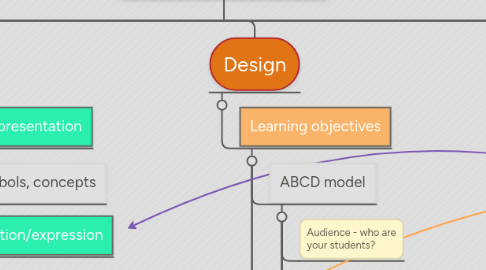
1. Monday's class
1.1. Why does this class matter?
1.1.1. Rubber band assignment
1.1.1.1. So many details! Lesson needs detail and specification
1.1.1.2. Sequence can be important
1.1.2. Teaching is complex!
1.1.2.1. Establish objectives and assessment measurements
1.2. What is I.D.?
1.2.1. Analyze and address root problems
1.2.2. Cost- and effort-efficiency
1.2.3. Focus on outcome, not behavior
1.3. Trends affecting I.D.
1.3.1. Macro trends
1.3.1.1. New technologies
1.3.1.2. "Constant change is here to stay"
1.3.1.3. Cost is decreasing workforce
1.3.1.4. Shift from skill- to knowledge-capital
1.3.1.5. Diversity, globalization
1.3.2. Micro trends
1.3.2.1. Demand for speed and skill in I.D.
1.3.2.2. Focus on how people learn
1.3.2.3. Accountability of I.D.ers
1.4. Performance Analysis Models
1.4.1. Comprehensive - big picture
1.4.2. Situation specific - frequent issues
1.5. Needs Assessment
1.5.1. Assessment v. analysis
1.5.2. Assessment plans
1.5.2.1. Why is this assessment being conducted?
1.5.2.2. Where should the assessment start?
1.5.2.3. Who is the audience?
1.5.2.4. What are the objectives?
1.5.2.5. How will you collect data?
1.6. ADDIE model
2. Analysis
2.1. Types of analyses
2.1.1. Task analysis
2.1.1.1. What is the required task?
2.1.1.2. Necessary prerequirements
2.1.1.3. What kind of learning is expected
2.1.2. Content analysis
2.1.2.1. What is being used to accomplish the task?
2.1.2.2. Is this tool appropriate for the task?
2.1.3. Performance analysis
2.1.3.1. Are students achieving the goal?
2.1.3.2. Is there an achievement gap?
3. UbD
3.1. Focus on transfer of ideas/skills/knowledge
3.2. Understanding
3.2.1. Explain
3.2.2. Interpret
3.2.3. Apply
3.2.4. Shift perspective
3.2.5. Empathize
3.2.6. Self-Assess
3.3. Backwards Planning
3.3.1. Determine objectives/goals and transfer tasks
3.3.2. Plan lesson based on objectives/standards
3.4. GRASP
3.4.1. Goal - objectives
3.4.2. Role - how will students be involved?
3.4.3. Audience - for whom are the students doing this task?
3.4.4. Situation - settings, supplies, tech, etc.
3.4.5. Performance - how well are the students expected to perform?
4. UDL
4.1. Multiple means of representation
4.1.1. Perception, symbols, concepts
4.2. Multiple means of action/expression
4.2.1. Don't just lecture!
4.2.2. Don't make every assessment the same way - test them with something besides just paper and pencil
4.3. Related to differentiation
4.4. Multiple means of engagement
4.4.1. Vary demands for tasks, not for reaching objective
4.4.2. Autonomy for students - give them choice
4.4.3. Mastery-oriented feedback
4.5. Can be applied with Multiple Intelligence Theory
5. Design
5.1. Learning objectives
5.1.1. ABCD model
5.1.1.1. Audience - who are your students?
5.1.1.2. Behavior - what will they do? (descriptive verb)
5.1.1.2.1. Wheel for descriptive verbs
5.1.1.3. Condition - given what?
5.1.1.3.1. Tools, equipment, setting, assistance
5.1.1.4. Degree - how well will the audience be able to perform the task? What degree of accuracy?
5.1.2. Terminal objectives
5.1.2.1. Goal for end results
5.1.3. Enabling objectives
6. Development
6.1. Gagnes' 9 Events
6.1.1. Hook
6.1.2. Give students objectives
6.1.3. Activate prior knowledge
6.1.4. Present content
6.1.5. Provide guidance
6.1.6. Elicit performance
6.1.7. Provide feedback
6.1.8. Assess performance
6.1.9. Enhance retention and transfer
6.2. Release of responsibility
6.2.1. Fisher and Frey
6.2.2. My adaption of Fisher and Fry's model
7. Implementation
7.1. Transitions
7.1.1. Poor transitions = significant loss of time
7.1.2. Set norms at beginning of year/unit
7.1.3. Whole-Brain Teaching
7.2. Relevance
7.2.1. If you don't give them a reason to care, they just might not.
7.2.2. Make objectives and application explicit
8. Evaluation
8.1. Summative
8.1.1. Evaluate learning
8.1.2. Exams, essays, etc.
8.1.3. High stakes
8.2. Formative
8.2.1. Monitor learning
8.2.2. Provide feedback of strengths/weaknesses
8.2.3. Low stakes
8.3. Technology as an evaluation tool
8.3.1. SMART response
8.3.2. Turning Point
8.3.3. Socrative
8.3.4. Questionnaires
8.3.5. Exams
9. Differentiation
9.1. Content, process, product, (environment)
9.1.1. These are what should be varied
9.1.2. Differentiation is NOT giving smart kids busy-work
9.2. Connected to UDL
9.2.1. Differentiation is specifically for students with learning differences. UDL is for them, but also for all students
9.3. Levels of learning
9.3.1. Different levels
9.3.1.1. Let them choose their own levels as long as they are appropriate and learning the content
9.3.2. Give students a choice of what to work on
9.3.2.1. Choose out of several options
9.3.2.2. Some necessary assignments, some choice assignments
